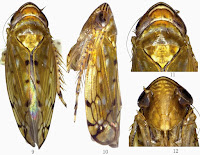The Lavender industry of Provence
generates about 30 million euros per year, directly employing around 10 000
people on about 2000, and employing a further 20 000 indirectly. The Lavender
farms are also a major draw to tourists, with the tourism industry generating
another $1.7 billion per year in the region. Two main plants are used in the
industry, True Lavender, Lavandula
angustifolia, and Lavandin, Lavandula
x intermedia, which is a hybrid between True Lavender and Aspic Lavender, Lavandula latifolia. Lavandin has a stronger odour that True Lavender as well
as producing a higher yield, with about 80% of Lavender fields actually planted
with Lavandin. Two wild forms of Lavender, Lavandula
stoechas and Lavandula
spica are also known from the region. These are not grown commercially, and
are a known reservoir of pathogens for commercial Lavender, which is
susceptible to Insect such as Mealybugs and Plant Midges, as well as to
Insect-born diseases.
In a paper published in the
journal Zootaxa on 1 July 2015, Jean-François Germain of the unité Entomologie et Plantes Invasives at the Laboratoire de la Santé des Végétaux, Daniele Matile-Ferrero
of the Département de Systématique & Evolution at the Muséum nationald’Histoire naturelle, Bora Kaydan of the Imamoglu Vocational School at Çukurova Üniversity, Thibaut Malausa of the Institut Agrobiotech at University of Nice Sophia Antipolis and DJ Williams of the Department of Life Sciences, The NaturalHistory Museum describe a new species of Mealybug found to be attacking and
damaging Lavandin Plants in the Drôme Department of Provence, which is the
heart of the Lavender industry.
The new species is placed in the
genus Dysmicoccus and given the
specific name lavandulae, in
reference to its host plant. The species is described from 35 adult and six
subadult specimens, all female. The specimens are greyish in colour, and
1.44-2.96 mm in length, No males could be located, but the species appears to
reproduce sexually so they are likely to be present.
Dysmicoccus lavandulae, (a)
Adult female in alcohol (scale 1 mm), (b) slide of the adult female, (c) adult
female on slide. Germain et al.
(2015).
This new species is notably
elongate for a Mealybug feeding on broad-leaved plants (some species living and
feeding within grass stems are longer. It lives on the spike and flower buds,
feeding at the base of these and causing leaf distortion which damages the
crop. After the Lavender is harvested surviving Mealybugs migrate downwards,
attacking the lower stems or even roots.
Leaf distortion of a young host plant (Lavandula x intermedia) caused by the feeding of Dysmicoccus lavandulae. Germain et al.
(2015).
See also...
 A new species of Leafhopper from Yunnan Province, China. Leafhoppers, Cicadellidae, are small True Bugs,
Hemiptera, closely related to Cicadas. They feed by draining sap from plants
through modified needle-like mouthparts, and can reach very high densities on...
A new species of Leafhopper from Yunnan Province, China. Leafhoppers, Cicadellidae, are small True Bugs,
Hemiptera, closely related to Cicadas. They feed by draining sap from plants
through modified needle-like mouthparts, and can reach very high densities on... Restharrow dwelling Aphid from France and Spain. Aphids are small members of the
Insect Order Hemiptera (True Bugs) which feed by sucking sap from host Plants.
They are often considered serious agricultural pests due to their very high...
Restharrow dwelling Aphid from France and Spain. Aphids are small members of the
Insect Order Hemiptera (True Bugs) which feed by sucking sap from host Plants.
They are often considered serious agricultural pests due to their very high...
Scale Insects are Hemipteran plant-parasites, closely related to
Aphids. There are over 7900 living species, as well as an extensive fossil
record, dating back to the Early Cretaceous. Most of the taxonomy of recent...
Follow Sciency Thoughts on
Facebook.



